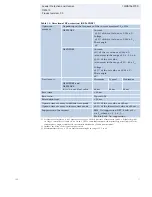
ABB
13
Feeder Protection and Control
REF615
Product version: 2.0
1MRS756379 D
protection blocks, time stamp, etc. The fault
recording can be triggered by the start signal
or the trip signal of a protection block, or
by both. The available measurement modes
include DFT, RMS and peak-to-peak. In addi-
tion, the maximum demand current with time
stamp is separately recorded. By default, the
records are stored in a non-volatile memory.
10. Circuit-breaker
monitoring
The condition monitoring functions of the
IED constantly monitors the performance
and the condition of the circuit breaker. The
monitoring comprises the spring charging
time, SF6 gas pressure, the travel-time and
the inactivity time of the circuit breaker.
The monitoring functions provide opera-
tional CB history data, which can be used for
scheduling preventive CB maintenance.
11. Trip-circuit
supervision
The trip-circuit supervision continuously
monitors the availability and operability of
the trip circuit. It provides open-circuit moni-
toring both when the circuit breaker is in its
closed and in its open position. It also detects
loss of circuit-breaker control voltage.
12. Self-supervision
The IED’s built-in self-supervision system
continuously monitors the state of the IED
hardware and the operation of the IED
software. Any fault or malfunction detected
will be used for alerting the operator. A per-
manent IED fault will block the protection
functions of the IED to prevent incorrect IED
operation.
13. Fuse failure
supervision
Depending on the chosen standard configura-
tion, the IED includes fuse failure supervision
functionality. The fuse failure supervision
detects failures between the voltage meas-
urement circuit and the IED. The failures
are detected by the negative-sequence based
algorithm or by the delta voltage and delta
current algorithm. Upon the detection of a
failure the the fuse failure supervision func-
tion activates an alarm and blocks voltage-
dependent protection functions from unin-
tended operation.
14. Current circuit
supervision
Depending on the chosen standard configura-
tion, the IED includes current circuit supervi-
sion. Current circuit supervision is used for
detecting faults in the transformer secondar-
ies and wiring. On detecting of a fault the
current circuit supervision function activates
an alarm and/or blocks certain protection
functions to avoid unintended operation. The
current circuit supervision function calculates
the sum of the phase currents and compares
the sum with the measured single reference
current from a core balance current trans-
former or from another set of phase current
transformers.
Summary of Contents for relion REF615
Page 1: ...Power Products Feeder Protection and Control REF615 Product Guide...
Page 53: ......
Page 54: ......
Page 55: ......














































